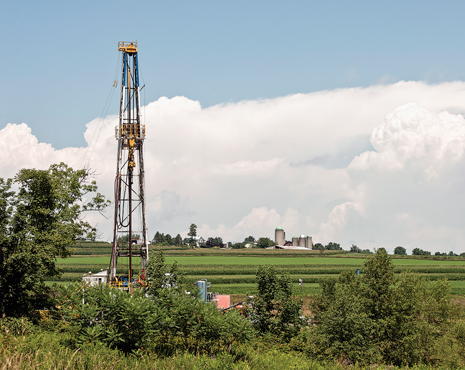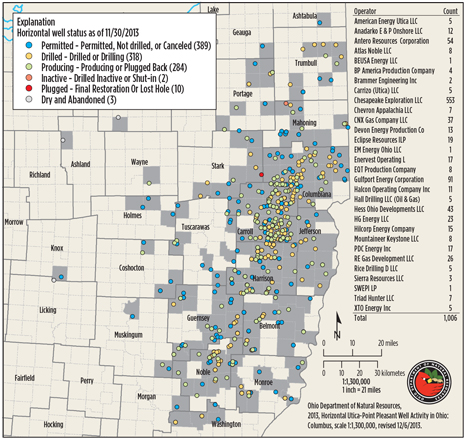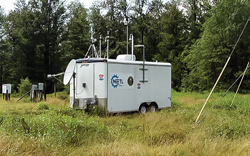 |
| As clearly illustrated in this Cabot Oil & Gas wellsite, the weather has made tough sledding for Marcellus/Utica shale operators this winter (photo courtesy of Cabot Oil & Gas Corp.). |
|
Compared to the deep freeze that has ensnared the U.S. East Coast this winter, the Marcellus/Utica shale play has been downright tropical. To be sure, given the production over the past year, and the continual development, the Marcellus/Utica has become to wet and dry gas what the Bakken is to crude, making it somewhat of an outlier to the typical shale strategy that has turned largely to the more oil-dominant plays.
“The Marcellus is a Goliath. In some ways, we’re just at the tip of the iceberg,” David Schlosser, senior V.P. for engineering and strategic planning for prolific local player EQT Corp., told Bloomberg on Oct. 31. Schlosser’s comments echoed the general sentiment attached to the 95,000-sq-mi combo play that stretches across most of the Appalachian basin.
The latest U.S. Energy Information Administration (EIA) statistics show the nation’s most productive shale gas play churning out more gas than expected in earlier forecasts, reaching a cumulative 1.4 Tcf for the first half of 2013, or around 13 Bcfd, after producing a meager 2 Bcfd at the start of the decade. According to EIA, the Marcellus now accounts for roughly 18% of the nation’s total gas production. “The rise of Marcellus production in both absolute terms, and as a share of total U.S. production, is a key development in a rapidly evolving U.S. natural gas market,” said EIA upon the Dec. 10 release of the latest production data.
In its most recent reserve assessment, the U.S. Geological Survey (USGS), in late 2011, pegged the middle Devonian Marcellus shale with holding about 84 Tcf of undiscovered, and technically recoverable, gas and 3.4 billion bbl of recoverable NGL. That assessment, however, did not take into consideration the then relatively unexplored Utica. Based on EIA’s reserve assessments, Deloitte estimated, in a November report, that up to 90,000 new Marcellus wells will be drilled over the next 20 years.
While the delineated fairway of the Marcellus/Utica play extends across New York, Pennsylvania, Ohio, West Virginia and Maryland, it is Pennsylvania that is responsible for an estimated 80% of aggregate production, followed by West Virginia. New York and Maryland are, basically, non-participants in the play.
Despite the continual environmental complaints elsewhere, the combined rig count for the Marcellus and the underlying Utica has remained stable over the past year. According to Baker Hughes, as of Jan. 10, a total of 124 rigs (Fig. 1) were active in the twin plays, the same tally as the like period last year, courtesy of an increase in Utica activity that offset a year-over-year drop in the Marcellus count. However, Baker Hughes also shows new Marcellus wells up 32% in the fourth quarter, reaching 576, as compared to the 435 new wells during the like quarter of 2012. This, again, reflects the enhanced per-rig efficiencies that characterize most of the U.S. shale plays. The emerging Utica, meanwhile, saw 5% fewer new wells drilled (about 112) in the quarter, as compared to 118 wells drilled in fourth-quarter 2012. However, the new Utica well count is trending upward, when compared to third-quarter 2013, when 110 new wells were documented.
 |
| Fig. 1. Forecasts point to increased drilling activity, as reflected in this Statoil USA wellsite in Pennsylvania (photo courtesy of Helge Hansen for Statoil). |
|
While Chevron and Exxon Mobil, through its XTO subsidiary, have considerable holdings, most of the acreage within the core Marcellus/Utica is controlled by scores of U.S.-based independents. Canada’s Talisman, with 217,000 net acres in Pennsylvania, and Statoil, with 70,000 net acres, are the only international operators with significant, controlling interests.
TOP TWO PRODUCERS
Thanks to the dry and wet gas horizons within its borders, Pennsylvania has been elevated to the nation’s third-largest, and fastest-growing, gas producer. EIA reported that through mid-July 2013, dry gas production in southern Pennsylvania rose to 1.7 Bcfd, from 0.86 Bcfd during the same period a year earlier. The state’s Department of Environmental Protection (DEP) listed Chesapeake Energy as the most active operator, with Cabot Oil & Gas Corp. operating seven of the state’s top 10 producing wells.
As of Jan. 14, there were 55 rigs actively making hole in the Keystone State, including three targeting the Utica. The DEP’s Office of Oil and Gas Management also issued 123 new unconventional drilling permits between Dec. 15-28.
To the south in West Virginia, where coal remains a revered king, Marcellus production during the same period likewise increased to 2.34 Bcfgd, compared to 1.55 Bcfgd during the same six-month period a year earlier, representing a 51% jump.
EIA production statistics in the December report came as no surprise to Corky Demarco, executive director of the West Virginia Oil and Natural Gas Association, who said in a statement that the growth rate, while impressive, will only continue to increase. “We have only drilled about 5% of the Marcellus wells we can drill in West Virginia,” he said. “I would suspect we will continue to increase our position.”
Meanwhile, between January and September 2013, the West Virginia Department of Environmental Protection (DEP) issued 491 horizontal drilling permits. As of Jan. 14, there were 34 rigs active in the state’s portion of the Marcellus shale.
UTICA FUELS OHIO
Despite higher well costs than those of its overlying cousin, impressive initial production (IP) rates have, so far, made the Utica/Point Pleasant the up-and-coming shale play de jour. Magnum Hunter Resources, which sold its Eagle Ford properties in South Texas, partly to focus on the Utica, says its southeastern Ohio leasehold was largely responsible last year for a 23% year-over-year increase in reserves. Prolific producer Gulfport Energy, for another, credits the Utica with a leading role in making 2013 one of its most successful.
The Ohio Department of Natural Resources (DNR) says that the estimated high total organic content (TOC) of up to 4.85% of the Utica/Point Pleasant is lower than that of the Marcellus, but the areal reach of the play is significantly larger. In fact, it has been said that if the full breadth of the Utica was found to be commercial, geographically, it would be the largest known dry and wet gas shale play. As delineated, the Utica extends across portions of Kentucky, Maryland, New York, Ohio, Pennsylvania, Tennessee, West Virginia, Virginia, and across the Canadian border into Quebec. To date, however, most of the Utica-specific E&P focus has centered primarily on the liquids potential within eight counties in eastern Ohio and, to a lesser degree, Pennsylvania.
Eastern Ohio stands as the Utica hub, with the latest state data, covering the 245 horizontal Utica wells then onstream, showing cumulative third-quarter production of 1.33 MMbbl of liquids and 33.61 Bcfg, Fig. 2. In releasing its first-ever, legally mandated, quarterly production report, the DNR’s Division of Oil and Gas Resources Management said the typical Utica shale well produced 137.2 MMcf and 5,439 bbl of gas and liquids, respectively, between last July and September. According to state statistics, third-quarter 2013 Utica production, in Ohio, alone, was double that of the entire previous year.
 |
| Fig. 2. Ohio Utica/Point Pleasant activity as of Nov. 30, 2013. Source: Ohio Department of Natural Resources. |
|
Reflecting the attractive flows being reported, Carrizo Oil & Gas on Jan. 16 released the results of its first Utica shale well, showing it testing at a peak rate of 1,680 bcpd, 5.2 MMcfd of residual gas and 266 bpd of NGLs, assuming ethane rejection and a 7% gas shrink. Completed with 31 frac stages, the Rector 1H in Guernsey County, Ohio, was drilled to 7,456 ft, TVD, with an effective lateral of 7,890 ft.
Going forward, it would appear that operators’ attraction to the Utica/Point Pleasant is not waning. As of Dec. 28, the DNR had issued 1,033 new Utica shale drilling permits to more than 30 operators—more than double the 525 permits that it had projected for the year. The year-end 2013 authorizations were a nearly three-fold increase over the 376 permits approved in 2012.
All five new Utica drilling permits that the DNR issued for the week of Dec. 29-Jan. 4 were issued to Chesapeake Energy, according to a Powell Shale Digest breakdown. Ironically, in November, the DNR issued five horizontal drilling permits in Harrison County to American Energy Utica LLC, a subsidiary of American Energy Partners LP, the new company headed up by Chesapeake founder and former CEO Aubrey McClendon.
STACKED PLAY POTENTIAL
Ranging in thickness up to 300 ft in its most easterly segment, the Marcellus is organic-rich black shale with a TOC said to be as high as 18%. The known source rock for many of the conventional vertical wells drilled in the Appalachian basin, the Marcellus is the basal portion of the Middle to Upper Devonian black shales. The play reaches depths approaching 9,000 ft in parts of southwestern and northeastern Pennsylvania, according to the Pennsylvania Department of Conservation and Natural Resources (DCNR).
The Marcellus overlies the Ordovician Utica and Point Pleasant shales, which can reach underlying depths of up to 7,000 ft, but in parts of the eastern Ohio epicenter, the emerging play can be found less than 3,000 ft below the Marcellus. The net thickness of the Utica/Point Pleasant averages roughly 290 ft, with average permeability of 546 ND, effective porosity of 4.2% and water saturation of 9.5%.
Marcellus/Utica first mover Range Resources and others point to the combo Upper Devonian, Marcellus and Utica/Point Pleasant as a promising stacked-play, liquids-rich resource. While the multiple-play potential is pronounced in northwestern Pennsylvania, the current lack of a viable processing and takeaway infrastructure, in that sector of the play, remains a significant issue. Range Resources, which claims to have effectively “cracked the code of the Upper Devonian,” says the stacked play potential is most pronounced in southwestern Pennsylvania.
Range says that not only does the southwestern quadrant contain a comparatively more well-developed infrastructure and takeaway capacity, it holds extremely fertile dry and wet gas horizons that make the area highly favorable for stacking. CEO Jeffrey L. Ventura said that taking the multiple-play prospects into account effectively doubles the roughly one million net acres that Range holds in Pennsylvania.
EFFICIENCIES INCREASING
Owing to the Marcellus being more developed, many operators are able to employ a factory-type approach to their pad drilling and completion operations, to help reduce costs. In a recent shale productivity report, EIA cited the Marcellus as delivering the highest per-rig efficiencies of the shale gas plays. A case-in-point is Range Resources, which said that since last year it has increased its average frac stages 18%, from 166/month to 196/month, using the same number of frac crews and equipment.
More recently, Cabot Oil & Gas said that the use of Baker Hughes’ bi-fuel frac fleet, on its latest multi-well pad, not only reduced its overall well costs, but also helped mitigate harmful diesel-generated emissions. The bi-fuel technology provided power for all the fracing operations on the 10-well pad, using line gas from nearby Cabot producing wells, the operator said. According to Cabot, the bi-fuel frac fleet reduced both costs and the operator’s environmental footprint.
ENVIRONMENTAL ANALYSIS
Pennsylvania operators are studying the likely ramifications of a state Supreme Court ruling from December that, on the surface, would appear to allow municipalities the right to block drilling within their boundaries. The ruling essentially invalidated the so-called Act 13, which the legislature enacted in 2012 to prevent municipalities from blocking drilling. The industry fears the court ruling could see more towns being swayed by anti-fracing activists and weaken activity within Pennsylvania.
The Marcellus Shale Coalition was quick to react with its president, Dave Spigelmyer, issuing a statement, on Dec. 19, which said that the industry group is evaluating the full impact of the ruling on operations in the state. “As we did prior to enactment of Act 13, and have done during this period of review by the state Supreme Court, Pennsylvania’s natural gas industry will continue to work collaboratively with the communities in which we operate, to ensure shale development moves forward, and we continue to realize the benefits at the local level and statewide,” said Spigelmyer. “Although we will continue to collaborate with communities across the Commonwealth, today’s decision is a disappointment, and represents a missed opportunity to establish a standard set of rules governing the responsible development and operation of shale gas wells in Pennsylvania.”
Meanwhile, amid continuing environmental protests, the U.S. Department of Energy’s National Energy Technical Laboratory (NETL) says it continues to evaluate the results of an ongoing, multi-faceted environmental impact study of the states within the Marcellus corridor, Fig. 3. According to NETL, the study has been underway since early last summer, at a central test site in Pennsylvania, with the aim of “conducting research that accurately assesses the impact of unconventional gas development on the ecosystems, where gas plays are located, to provide regulators with an impartial, scientific basis for possible rulemaking.”
 |
| Fig. 3. A portable air quality monitoring trailer on location at the federal environmental analysis test site in Pennsylvania (photo courtesy of the U.S. National Energy Technical Laboratory). |
|
STRONG YEAR AHEAD
With nearly all the E&P operations controlled by numerous independents, a sampling of the 2013 and planned 2014 activities hints to increased activity in both the Marcellus and the emerging Utica plays.
Cabot Oil & Gas closed out 2013 by unveiling its first 10-well pad within the 200,000 net acres that it holds in the Marcellus dry gas window, primarily in Susquehanna County, Pennsylvania. Cabot says the pad, which includes eight Lower Marcellus and two Upper Marcellus wells, with 170 cumulative frac stages, has a combined peak production rate of 201 Mcfgd with an aggregate 30-day production rate of 168 Mcfgd. Cabot says the new pad marked a number of operational efficiencies, including de-risking the Upper Marcellus and successfully pilot-testing 500-ft downspacing. In July, Cabot’s overall Marcellus production reached more than 1.2 Bcfgd from 226 operated horizontal producers.
The independent brought a sixth rig into the Marcellus in late 2013 and drilled 100 net wells. Cabot says its 2013 drilling program averaged three to four additional frac stages per well and, between longer laterals and tighter frac stage spacing, it was able to increase estimated ultimate recoveries per 1,000 ft of lateral.
Range Resources said at year-end that it reached a milestone of more than 1 Bcfed of gross production from its one million-plus net acres in the Pennsylvania Marcellus, of which 540,000 net acres are in the highly prospective southwestern area. One of the area’s largest producers, Range is at the forefront in evaluating the stacked play potential and said it plans to drill at least one Utica/Point Pleasant horizontal well in its southwestern Pennsylvania acreage this year.
In its latest earnings report, Range said it brought 24 “super-rich” Marcellus wells online at the end of the third quarter, with an average IP of 2,657 boed, 66% of it liquids. While most activity is centered in the southwestern quadrant, Range also is running one rig in northeastern Pennsylvania, where it holds 145,000 net acres, of which 69% are held by production (HBP).
Gulfport Energy Corp. focuses entirely on the Utica shale, where it holds some 147,350 net acres in eastern Ohio, with proved reserves estimated at 6.59 net MMboe and 18.18 net MMboe in probable reserves. Gulfport reached record Utica production of 27,780 boed on New Year’s Eve, which represents a 340% growth rate from the previous year. The independent is operating seven rigs and this year plans to drill 64 to 71 net wells.
Chesapeake Energy, which early last year reportedly held 1.8 million net acres in the Marcellus, continues as one of the most active players and, after a number of asset sales, retains significant holdings in the Utica, northern Marcellus, and the wet southern portion of the play. As of Sept. 30, Chesapeake averaged 11 rigs and put 63 gross wells onstream in its Utica holdings of eastern Ohio and Pennsylvania, where the operator had drilled 377 wells. Production in the third quarter averaged approximately 164 MMcfed, a 91% increase over the previous quarter. In the northern Pennsylvania Marcellus, Chesapeake ran five rigs and connected 37 gross wells to sale, averaging 825 MMcfed, a 53% year-over-year increase. In its wet-gas southern Marcellus properties, in Pennsylvania and West Virginia, Chesapeake operated three rigs during the quarter and put 30 gross wells online, with average production of 275 MMcfed.
As part of its JV with Total S.A., Chesapeake committed to spudding no less than 270 cumulative wells in the play by December 31, with a commitment for 540 aggregate wells drilled by July 15, 2015.
In late December, Consol Energy Inc., and its JV partner, Noble Energy, snapped up drilling rights to 90,000 acres in West Virginia from Dominion Resources, nearly half of which are prospective for wet gas. Before the latest acquisition, the firm held 361,000 net Marcellus acres, scattered across Pennsylvania, West Virginia and New York. Last year, Consol drilled a cumulative 148 shale wells, including 123 in the Marcellus and 25 in the Utica. At year-end, 11 wells on three Washington County, Pennsylvania, pads were put online, producing an average 10.7 MMcfgd, while its first six-well pad in Barbour County, West Virginia, went into production with an average IP of 13.6 MMcfed.
Southwestern Energy Co. plans to drill between 75 and 80 Marcellus wells this year on the 337,000 net acres that it now holds in northeastern Pennsylvania, following the 2013 acquisition of 162,000 net acres formerly controlled by Chesapeake. In its latest earnings report, Southwestern recorded third-quarter net production of 44.7 Bcfg, from its 151 operated wells. The operator expects total 2014 net production to increase more than 60% to 244-249 Bcfg, compared to the aggregate 148-149 Bcfg that it projected for year-end 2013. In the fourth quarter, Southwestern drilled its first Sullivan County, Pennsylvania, well on a portion of the acquired acreage, and it plans its first wells in Wyoming and Tioga counties early this year.
EQT Production plans an aggressive, multiple-zone drilling campaign this year, targeting Upper Devonian, Marcellus and Utica prospects. The independent plans to invest roughly $1.1 billion and drill 186 wells in its 560,000-acre Marcellus properties, primarily in its core southwestern Pennsylvania and northern West Virginia holdings. EQT plans to drill 21 wells in the 14,000 net acres that it controls in the liquids-rich Utica, in Guernsey County, Ohio. In addition, the operator plans to drill 30 wells on its 170,000 net acres that are prospective for the Upper Devonian, which will share a pad with Marcellus wells. EQT believes the Upper Devonian can be developed as a separate zone. Last May, EQT acquired 99,000 acres and 10 wells in southwestern Pennsylvania’s Marcellus and Utica shales from Chesapeake.
Halcon Resources plans to operate a single rig this year to evaluate its net 143,000-acre Utica/Point Pleasant position in Ohio and Pennsylvania. Halcon closed the year by drilling nine wells, with three connected to sales. Halcon said near-term drilling will be limited to the southwest portion of its acreage in Trumbull and Mahoning Counties, Ohio.
Antero Resources Corp., which went public in October, holds more than 400,000 combined Marcellus/Utica acres in Pennsylvania, Ohio and West Virginia, with a total proved reserve base of 6.3 Tcfe. Of its combined holdings, Antero controls 366,000 net acres prospective for the Marcellus, where it runs an average 15 rigs. Antero runs five rigs in its 104,000-acre Utica leasehold.
Exco Resources plans to drill two gross appraisal wells this year within the 128,000 net acres it holds in the northeast Pennsylvania Marcellus play. Exco operates some 110 Marcellus wells, with roughly 66% of its acreage held by production.
Ultra Petroleum holds 261,000 net acres in the Pennsylvania Marcellus, which the operator said netted production of 175 MMcfed. The independent has identified 1,700 future drilling sites, and, in the third quarter, participated in the drilling of eight gross (four net) horizontal Marcellus wells and initiated gross production from six wells.
PDC Energy says it will suspend Marcellus dry gas drilling this year and focus, instead, on nearly 50,000 net acres it holds in the Ohio Utica shale. PDC has earmarked approximately $162 million for its 2014 Utica program, in southeastern Ohio, where it plans to spud 18 horizontal wells.
Carrizo Oil & Gas, after its October acquisition of some 5,900 net acres in Ohio’s Guernsey and Noble counties, from affiliates of JV partner Avista Capital, LP, holds a combined Marcellus-Utica leasehold of approximately 70,900 acres. Of that, 21,700 net acres lie in the condensate sweet spot of the Utica core. Along with its newly completed Utica well, Carrizo said that it drilled six gross wells in the Marcellus during the third quarter, while completing and bringing five gross wells on production. The Houston-based independent recorded third-quarter Marcellus production of 36.4 MMcfgd, up from 33.9 MMcfgd from the prior quarter. Elsewhere, Carrizo plans to run a one-rig drilling program in its Utica holdings for the rest of 2014. 
|







